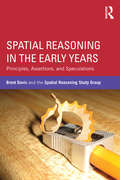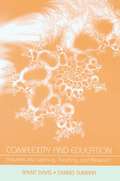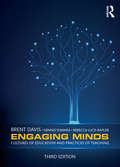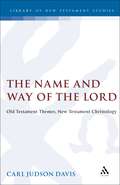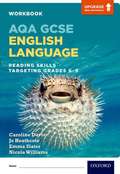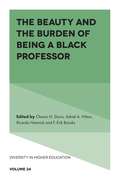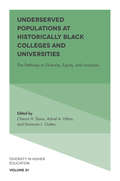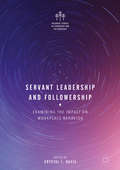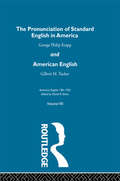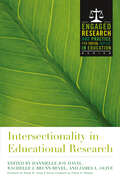- Table View
- List View
Spatial Reasoning in the Early Years: Principles, Assertions, and Speculations
by Brent Davis Spatial Reasoning Study GroupOver the past several years, "spatial reasoning" has gained renewed prominence among mathematics educators, as spatial skills are proving to be not just essential to mathematical understanding but also strong predictors of future success beyond the classroom in fields such as science, technology, and engineering. By exploring both primary and emergent dimensions, Spatial Reasoning in the Early Years helps define the concept of spatial reasoning and provides compelling evidence of the need for a clear focus within early education specifically. The authors review the research, look across current theories, and investigate implications for contemporary school mathematics pedagogy as they identify areas of inquiry necessary to bring a stronger spatial reasoning emphasis into the classroom. The book contains many classroom- or workshop-based vignettes, highlighting the complexity of spatial reasoning in educational practice, providing an in-depth analysis of spatial reasoning as it applies to classroom practice, and offering new ways of framing lessons to help young students hone their spatial reasoning abilities. The book concludes with a forward-looking agenda that contributes to developing a greater understanding of the role spatial reasoning plays in educational contexts and beyond. Supported by plentiful visual representations, Spatial Reasoning in the Early Years skillfully integrates the conceptual and the concrete, making this text a dynamic and accessible resource.
Spatial Reasoning in the Early Years: Principles, Assertions, and Speculations
by Brent Davis Spatial Reasoning Study GroupOver the past several years, "spatial reasoning" has gained renewed prominence among mathematics educators, as spatial skills are proving to be not just essential to mathematical understanding but also strong predictors of future success beyond the classroom in fields such as science, technology, and engineering. By exploring both primary and emergent dimensions, Spatial Reasoning in the Early Years helps define the concept of spatial reasoning and provides compelling evidence of the need for a clear focus within early education specifically. The authors review the research, look across current theories, and investigate implications for contemporary school mathematics pedagogy as they identify areas of inquiry necessary to bring a stronger spatial reasoning emphasis into the classroom. The book contains many classroom- or workshop-based vignettes, highlighting the complexity of spatial reasoning in educational practice, providing an in-depth analysis of spatial reasoning as it applies to classroom practice, and offering new ways of framing lessons to help young students hone their spatial reasoning abilities. The book concludes with a forward-looking agenda that contributes to developing a greater understanding of the role spatial reasoning plays in educational contexts and beyond. Supported by plentiful visual representations, Spatial Reasoning in the Early Years skillfully integrates the conceptual and the concrete, making this text a dynamic and accessible resource.
Complexity and Education: Inquiries Into Learning, Teaching, and Research
by Brent Davis Dennis SumaraThis book explores the contributions, actual and potential, of complexity thinking to educational research and practice. While its focus is on the theoretical premises and the methodology, not specific applications, the aim is pragmatic--to present complexity thinking as an important and appropriate attitude for educators and educational researchers. Part I is concerned with global issues around complexity thinking, as read through an educational lens. Part II cites a diversity of practices and studies that are either explicitly informed by or that might be aligned with complexity research, and offers focused and practiced advice for structuring projects in ways that are consistent with complexity thinking. Complexity thinking offers a powerful alternative to the linear, reductionist approaches to inquiry that have dominated the sciences for hundreds of years and educational research for more than a century. It has captured the attention of many researchers whose studies reach across traditional disciplinary boundaries to investigate phenomena such as: How does the brain work? What is consciousness? What is intelligence? What is the role of emergent technologies in shaping personalities and possibilities? How do social collectives work? What is knowledge? Complexity research posits that a deep similarity among these phenomena is that each points toward some sort of system that learns. The authors’ intent is not to offer a complete account of the relevance of complexity thinking to education, not to prescribe and delimit, but to challenge readers to examine their own assumptions and theoretical commitments--whether anchored by commonsense, classical thought or any of the posts (such as postmodernism, poststructuralism, postcolonialism, postpositivism, postformalism, postepistemology) that mark the edges of current discursive possibility. Complexity and Education is THE introduction to the emerging field of complexity thinking for the education community. It is specifically relevant for educational researchers, graduate students, and inquiry-oriented teacher practitioners.
Complexity and Education: Inquiries Into Learning, Teaching, and Research
by Brent Davis Dennis SumaraThis book explores the contributions, actual and potential, of complexity thinking to educational research and practice. While its focus is on the theoretical premises and the methodology, not specific applications, the aim is pragmatic--to present complexity thinking as an important and appropriate attitude for educators and educational researchers. Part I is concerned with global issues around complexity thinking, as read through an educational lens. Part II cites a diversity of practices and studies that are either explicitly informed by or that might be aligned with complexity research, and offers focused and practiced advice for structuring projects in ways that are consistent with complexity thinking. Complexity thinking offers a powerful alternative to the linear, reductionist approaches to inquiry that have dominated the sciences for hundreds of years and educational research for more than a century. It has captured the attention of many researchers whose studies reach across traditional disciplinary boundaries to investigate phenomena such as: How does the brain work? What is consciousness? What is intelligence? What is the role of emergent technologies in shaping personalities and possibilities? How do social collectives work? What is knowledge? Complexity research posits that a deep similarity among these phenomena is that each points toward some sort of system that learns. The authors’ intent is not to offer a complete account of the relevance of complexity thinking to education, not to prescribe and delimit, but to challenge readers to examine their own assumptions and theoretical commitments--whether anchored by commonsense, classical thought or any of the posts (such as postmodernism, poststructuralism, postcolonialism, postpositivism, postformalism, postepistemology) that mark the edges of current discursive possibility. Complexity and Education is THE introduction to the emerging field of complexity thinking for the education community. It is specifically relevant for educational researchers, graduate students, and inquiry-oriented teacher practitioners.
Engaging Minds: Cultures of Education and Practices of Teaching
by Brent Davis Dennis Sumara Rebecca Luce-KaplerEngaging Minds: Cultures of Education and Practices of Teaching explores the diverse beliefs and practices that define the current landscape of formal education. The 3rd edition of this introduction to interdisciplinary studies of teaching and learning to teach is restructured around four prominent historical moments in formal education: Standardized Education, Authentic Education, Democratic Citizenship Education, Systemic Sustainability Education. These moments serve as the foci of the four sections of the book, each with three chapters dealing respectively with history, epistemology, and pedagogy within the moment. This structure makes it possible to read the book in two ways – either "horizontally" through the four in-depth treatments of the moments or "vertically" through coherent threads of history, epistemology, and pedagogy. Pedagogical features include suggestions for delving deeper to get at subtleties that can’t be simply stated or appreciated through reading alone, several strategies to highlight and distinguish important vocabulary in the text, and more than 150 key theorists and researchers included among the search terms and in the Influences section rather than a formal reference list.
Engaging Minds: Cultures of Education and Practices of Teaching
by Brent Davis Dennis Sumara Rebecca Luce-KaplerEngaging Minds: Cultures of Education and Practices of Teaching explores the diverse beliefs and practices that define the current landscape of formal education. The 3rd edition of this introduction to interdisciplinary studies of teaching and learning to teach is restructured around four prominent historical moments in formal education: Standardized Education, Authentic Education, Democratic Citizenship Education, Systemic Sustainability Education. These moments serve as the foci of the four sections of the book, each with three chapters dealing respectively with history, epistemology, and pedagogy within the moment. This structure makes it possible to read the book in two ways – either "horizontally" through the four in-depth treatments of the moments or "vertically" through coherent threads of history, epistemology, and pedagogy. Pedagogical features include suggestions for delving deeper to get at subtleties that can’t be simply stated or appreciated through reading alone, several strategies to highlight and distinguish important vocabulary in the text, and more than 150 key theorists and researchers included among the search terms and in the Influences section rather than a formal reference list.
The Name and Way of the Lord: Old Testament Themes, New Testament Christology (The Library of New Testament Studies #129)
by Carl Judson DavisThis book discusses the first-century implications of applying Old Testament texts about the divine to Jesus. It summarizes recent views on the significance of this practice. It then collects pre-Christian and first-century Jewish parallels, and notices that most centre on the angel, wisdom, glory and word of the Lord, although application to non-divine figures also occurs. The evidence is that some Christians in the 50s worked with a redefinition of monotheism in which they included the Father and Jesus. Such a view explains the New Testament salvation-historical perspective in regard to the Old Testament belief on the theophany of God and the belief in God as the object of invocation.
AQA GCSE English Language: Reading Skills Targeting
by Caroline Davis Nicola Williams Emma WinstanleyThis workbook provides a targeted approach to practising the key reading skills required in the AQA GCSE English Language exam: language and structural analysis, comparison and evaluation. With a focus on grades 6-9 and a question-by-question approach, students are able to take control of their skills development.
Oral Biblical Criticism: The Influence of the Principles of Orality on the Literary Structure of Paul's Epistle to the Philip (The Library of New Testament Studies #172)
by Casey W. DavisThe Apostle Paul expected the vast majority of the recipients of his letters to hear, not read, them. He structured his compositions for the ear rather than the eye. Pauline audiences would hear clues to meaning and structure because they had learned to communicate in a world where those clues were essential to understanding. Recognizable structures and patterns were essential for listeners to organize what they heard, to follow, to predict and to remember the flow of communication. Oral Biblical Criticism examines Paul's Epistle to the Philippians in light of recent study of oral principles of composition and interpretation.
The Beauty and the Burden of Being a Black Professor (Diversity in Higher Education #24)
by Cheron H. Davis Adriel A. Hilton Ricardo Hamrick F. Erik BrooksIt has been well chronicled that Black professors have experienced a long history of inequities and inequalities within the academic space. This volume explores the experiences, challenges and triumphs experienced by Black professors. Including personal essays written by Black professors, this volume showcases personal insights and inspirational stories from leading Black scholars across the US. It highlights and problematizes the uncomfortable truth of the lack of diversity in many higher education institutions in order to further discussions on the topic of race in academia, and to assist academics of color in preparing for their careers. Future academics will gain a sense of how to launch their careers, stay productive in research, teaching and service, and avoid the racial-related malaise that can hinder new academics of color. By presenting discussions on professional development, and emphasizing the challenges and triumphs experienced by Black professors across disciplines, this book provides advice for junior Black scholars on how to navigate academe and tackle the challenges that Black scholars often face.
Underserved Populations at Historically Black Colleges and Universities: The Pathway to Diversity, Equity, and Inclusion (Diversity in Higher Education #21)
by Cheron H. Davis Adriel A. Hilton Donavan L. OuttenThis book focuses on the lived experiences of underserved student and faculty populations at historically Black colleges and universities (HBCUs) and the implications these experiences have for higher education policy. Contributors discuss the contexts and experiences of students and faculty who navigate the political and social spaces of HBCUs while supporting healthy personal and robust professional goals. The stigmas and social nuances that plague students and faculty of color do not dissolve with their arrival at an HBCU, but rather they transform into a new set of challenges that demand the attention of researchers. Taking into account institutional supports, identity development, and socialization patterns, this book sheds light on what the experiences of higher education’s “outsiders” mean for future research and practice, while emphasizing issues of diversity, equity, and inclusion.
Servant Leadership and Followership: Examining the Impact on Workplace Behavior
by Crystal J. DavisProviding a deeper understanding of leadership, followership theory, and the follower as servant leader, this book provides employee and follower perspectives of servant leadership in the workplace. The collection brings together both empirical and conceptual research from around the globe to illustrate how the leader is seen through the lens of the follower. Topics discussed include organizational performance, empowerment, competency models, diversity in the workplace, and social roles and stereotypes. With contributions from a range of skilled authors, Servant Leadership and Followership not only provides an overview of servant leadership, but also offers insightful ways for organizations to adapt and progress in line with the shifting moral demands of today’s workplace.
Servant Leadership and Followership: Examining the Impact on Workplace Behavior
by Crystal J. DavisProviding a deeper understanding of leadership, followership theory, and the follower as servant leader, this book provides employee and follower perspectives of servant leadership in the workplace. The collection brings together both empirical and conceptual research from around the globe to illustrate how the leader is seen through the lens of the follower. Topics discussed include organizational performance, empowerment, competency models, diversity in the workplace, and social roles and stereotypes. With contributions from a range of skilled authors, Servant Leadership and Followership not only provides an overview of servant leadership, but also offers insightful ways for organizations to adapt and progress in line with the shifting moral demands of today’s workplace.
Servant Leadership and Followership: Examining the Impact on Workplace Behavior
by Crystal J. DavisProviding a deeper understanding of leadership, followership theory, and the follower as servant leader, this book provides employee and follower perspectives of servant leadership in the workplace. The collection brings together both empirical and conceptual research from around the globe to illustrate how the leader is seen through the lens of the follower. Topics discussed include organizational performance, empowerment, competency models, diversity in the workplace, and social roles and stereotypes. With contributions from a range of skilled authors, Servant Leadership and Followership not only provides an overview of servant leadership, but also offers insightful ways for organizations to adapt and progress in line with the shifting moral demands of today’s workplace.
Contingent Academic Labor: Evaluating Conditions to Improve Student Outcomes
by Daniel B. DavisContingent Academic Labor is a concise guide that offers higher education professionals a way to measure the degree of equality taking place in work environments for non-tenure track faculty across institutional settings. It frames the relevant issues and examines the nationwide situation facing contingent faculty across the professional landscape. The goal is to review contingent faculty treatment, and offer a standardized way to identify both equitable and unjust practices that impact adjunct faculty and their students by extension.The main feature of this guide is The Contingent Labor Conditions Score, a tool to help evaluate current labor practices that impact adjuncts in both positive and negative ways. The report card measures 3 areas of labor conditions:*Material Equity: Pay, job security and benefits*Professional Equity: Opportunities for advancement, professional development, academic freedom, sense of professional inclusion, and job satisfaction*Social Equity: Gender and race parity between contingent and non-contingent faculty in proportion to the population servedThis book will be useful for administrators and labor organizers alike in assessing the degree of exploitation, or empowerment, in their own institution. The Contingent Labor Conditions Score, as a standardized tool, will serve audiences on both sides of the discussion in creating positive steps forward, improving not only contingent faculty working conditions, but ultimately improving student outcomes.
Contingent Academic Labor: Evaluating Conditions to Improve Student Outcomes
by Daniel B. DavisContingent Academic Labor is a concise guide that offers higher education professionals a way to measure the degree of equality taking place in work environments for non-tenure track faculty across institutional settings. It frames the relevant issues and examines the nationwide situation facing contingent faculty across the professional landscape. The goal is to review contingent faculty treatment, and offer a standardized way to identify both equitable and unjust practices that impact adjunct faculty and their students by extension.The main feature of this guide is The Contingent Labor Conditions Score, a tool to help evaluate current labor practices that impact adjuncts in both positive and negative ways. The report card measures 3 areas of labor conditions:*Material Equity: Pay, job security and benefits*Professional Equity: Opportunities for advancement, professional development, academic freedom, sense of professional inclusion, and job satisfaction*Social Equity: Gender and race parity between contingent and non-contingent faculty in proportion to the population servedThis book will be useful for administrators and labor organizers alike in assessing the degree of exploitation, or empowerment, in their own institution. The Contingent Labor Conditions Score, as a standardized tool, will serve audiences on both sides of the discussion in creating positive steps forward, improving not only contingent faculty working conditions, but ultimately improving student outcomes.
Pronunc Standard Eng America V
by Daniel R DavisFirst Published in 2003. Routledge is an imprint of Taylor & Francis, an informa company.
Pronunc Standard Eng America V
by Daniel R DavisFirst Published in 2003. Routledge is an imprint of Taylor & Francis, an informa company.
Social Justice Issues and Racism in the College Classroom: Perspectives from Different Voices (International Perspectives on Higher Education Research #8)
by Dannielle Joy Davis Patricia G. Boyer Malcolm TightThe focus of Social Justice Issues and Racism in the College Classroom is faculty and students of color at postsecondary institutions and the racial challenges they encounter in college classrooms. To achieve this aim, the book highlights the voices of various racial/ethnic groups of faculty and students, including international scholars. Additionally, the book will inform and bring attention to non-minority faculty and students of social justice issues related to race in the classroom and offer suggestions on how to be supportive of people of color. Several frameworks will be utilized in this book to assist readers in better understanding ideas, concepts, and practices. Specifically, a social justice framework, critical race theory, and White privilege are used to better explore the featured topics. Both quantitative and qualitative (e.g., auto-ethnographic, interviews, etc.) data are utilized throughout the book to give voice to the authors. Questions posed for this edited book are as follows: How do faculty members include social justice issues related to race/ethnicity in their curricula? How are issues associated with race or ethnicity discussed in the classroom by students, as well as minority and nonminority faculty? What are the experiences of students of color in the classroom working with faculty of different races and ethnicities? Overall the book provides information to assist students and faculty of color with survival skills in complex environments.
Intersectionality in Educational Research (Engaged Research And Practice For Social Justice In Education Ser.)
by Dannielle Joy Davis Rachelle J. Brunn-Bevel James L. OliveThe purpose of this work is to advance understanding of intersectional theory and its application to research in education. The scholars whose work appear in this volume utilize intersectional theory and research methods to work in fields and disciplines such as Education, Sociology, Women’s Studies, Africana Studies, Human Development, Higher Education Administration, Leadership Studies, and Justice Studies. The book illustrates how intersectional theory can be used in both quantitative and qualitative education research on college student access and success, faculty satisfaction and professional development, and K-12 educational issues such as high school dropouts and bullying. This book is unique, as no other book ties intersectionality to the research process.Key Features:* Readers will learn the basic tenets of intersectionality and how it can be useful in education research.* Readers will learn how intersectionality can be used to analyze both quantitative (large scale survey) and qualitative (interview, participant observation, and ethnographic) data.* Lastly, readers will learn how intersectionality can be particularly useful in examining the experiences of diverse groups of students attending elementary schools, high schools, colleges and universities, and faculty working at post-secondary institutions.Intersectionality is increasingly being used in research and education. This theory holds great promise in exploring students’ experiences in terms of access, success, and outcomes for marginalized groups. In essence, application of the theory promotes critical complex thinking regarding the intersectionality of race, class, and gender and their outcomes.
Integrated Children's Services
by Dr John Emmeus DavisWorking together with fellow professionals across different sectors of children's services is central to good practice for all those who work with children and young people. This book looks at how children's services can work together more effectively; by taking an approach that is grounded in research, the book engages critically with both the benefits and the pitfalls of integrated working. The importance of relationships, roles, responsibilities and strategic planning is discussed, and chapters cover: - what integrated working looks like in practice - how early years services work - ethnicity - Child and Adolescent Mental Health Services (CAMHS) - disability and integrated working. The book encourages readers to reflect on their own background and how this influences their view of specific children, families and fellow professionals, as well as their own practice. Suitable for all those working with children and young people from birth to 19 years in any aspect of children's services, this book will ensure professionals work together successfully to the benefit of all.
Integrated Children's Services (PDF)
by Dr John Emmeus DavisWorking together with fellow professionals across different sectors of children's services is central to good practice for all those who work with children and young people. This book looks at how children's services can work together more effectively; by taking an approach that is grounded in research, the book engages critically with both the benefits and the pitfalls of integrated working. The importance of relationships, roles, responsibilities and strategic planning is discussed, and chapters cover: - what integrated working looks like in practice - how early years services work - ethnicity - Child and Adolescent Mental Health Services (CAMHS) - disability and integrated working. The book encourages readers to reflect on their own background and how this influences their view of specific children, families and fellow professionals, as well as their own practice. Suitable for all those working with children and young people from birth to 19 years in any aspect of children's services, this book will ensure professionals work together successfully to the benefit of all.
Researching with Children and Young People: Research Design, Methods and Analysis
by Dr John Emmeus Davis Michael Gallagher Professor E Kay Tisdall'This text will be of great use to postgraduate researchers in education, social work and nursing, and any practitioner involved in carrying out research with children and young people' - CPD Update '[T]here is a sense of newness and innovation about the book, whereby the reader is treated to insight into the life and work of collaborators who wrote each case study....[T]he book is highly accessible for students at graduate and undergraduate level, for example BA (Hons) Early Childhood Studies students' - ESCalate Researching with Children and Young People covers every stage of the process of doing a research project, from research design and data collection, through to analysis and writing up. The book is divided into three sections, in which the authors cover: - Introducing research and consultation with children and young people - Collecting and analysing data - Whole-project issues. Each chapter includes activities, discussion questions, tips and extended case studies to help the reader to engage with the material and investigate the practical implications. This text will be of great use to postgraduate researchers in education, social work and nursing, and any practitioner involved in carrying out research with children and young people.
Inclusive Leadership For Dummies
by Dr. Shirley DavisStrategies for creating a welcoming, equitable, and high-performing work environment Inclusive Leadership For Dummies helps leaders successfully navigate the nuances of a diverse workforce and create a culture where ALL talent can thrive. Toss out the one-size-fits-all leadership approaches, because the workforce is not a monolith—it’s a rich and beautiful tapestry made up of people from all backgrounds, cultures, skills, and experiences. This book enables you to develop the knowledge and competencies needed to lead diverse teams successfully. It also provides tips, tools, and techniques, for how to proactively respond to external pressures and disruptions like the changing workforce, marketplace, and the political and economic climate for how to foster and ensuring that all employees are included, valued, they feel safe, and they can do their best work. Discover the concept of inclusive leadership and learn what inclusive leaders do Evolve your own thinking and behaviors to promote inclusivity and a welcoming atmosphere Minimize your blind spots in meetings and interactions and overcome any blunders or pitfalls Gain inspiration from case studies of effective inclusive leadersFor emerging, mid-level, and senior leaders who want to foster greater trust, psychological safety, and a high performing work environment that leverages (or celebrates) all attributes of diversity Inclusive Leadership For Dummies is the resource for you.
Inclusive Leadership For Dummies
by Dr. Shirley DavisStrategies for creating a welcoming, equitable, and high-performing work environment Inclusive Leadership For Dummies helps leaders successfully navigate the nuances of a diverse workforce and create a culture where ALL talent can thrive. Toss out the one-size-fits-all leadership approaches, because the workforce is not a monolith—it’s a rich and beautiful tapestry made up of people from all backgrounds, cultures, skills, and experiences. This book enables you to develop the knowledge and competencies needed to lead diverse teams successfully. It also provides tips, tools, and techniques, for how to proactively respond to external pressures and disruptions like the changing workforce, marketplace, and the political and economic climate for how to foster and ensuring that all employees are included, valued, they feel safe, and they can do their best work. Discover the concept of inclusive leadership and learn what inclusive leaders do Evolve your own thinking and behaviors to promote inclusivity and a welcoming atmosphere Minimize your blind spots in meetings and interactions and overcome any blunders or pitfalls Gain inspiration from case studies of effective inclusive leadersFor emerging, mid-level, and senior leaders who want to foster greater trust, psychological safety, and a high performing work environment that leverages (or celebrates) all attributes of diversity Inclusive Leadership For Dummies is the resource for you.
